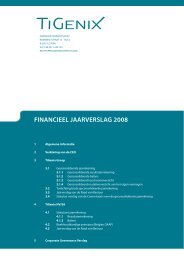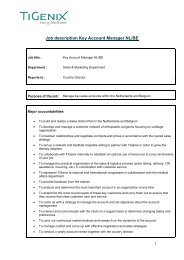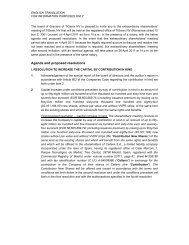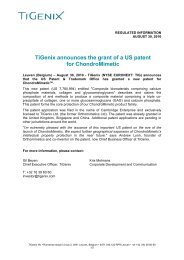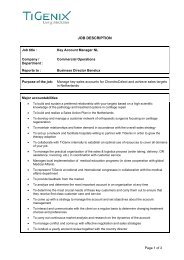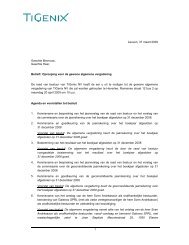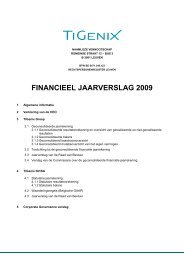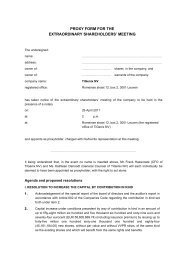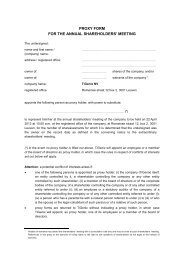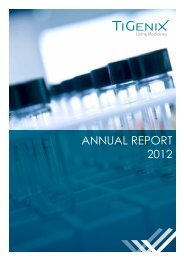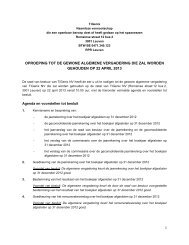ANNUAL FINANCIAL REPORT 2010 2010 - TiGenix
ANNUAL FINANCIAL REPORT 2010 2010 - TiGenix
ANNUAL FINANCIAL REPORT 2010 2010 - TiGenix
- No tags were found...
Create successful ePaper yourself
Turn your PDF publications into a flip-book with our unique Google optimized e-Paper software.
Of 2,391 patients included in the study, 581 had developedperianal fistula at some point since diagnosis of CD. The meantime of evolution of CD was 12 years. The cumulative incidenceof perianal fistula was 24% (CI95%: 22-30%) and the cumulativeincidence of complex perianal fistula was 12% (CI95%: 11-13%).The rate of incidence of development of perianal fistula was1.2% per patient-year during the study time period and forcomplex fistula it was 0.7% per patient-year. The median age ofpatients with perianal fistula was 41 years, and 55% were male.Based on this data, the study concluded that perianal fistulasare very common, appearing in 25% of CD patients, of whichapproximately half are complex. It also concluded that complexperianal fistulae are frequently associated with the presence ofperianal abscess and in a significant percentage of patients withanal stenosis.For Crohn patients, current treatment alternatives are verylimited and they are basically, antibiotics, immunosuppressantsand anti-TNFα (Remicade®/Infliximab).Although antibiotics are commonly used as first line therapyin fistulizing CD, the efficacy of these drugs has never beenshown in appropriate randomized clinical trial (RCT). A smallRCT failed to demonstrate statistical significance betweenantibiotics and placebo (Thia et al., 2009). However, antibioticsare currently recommended as fistula therapy in internationalclinical guidelines (Van Assche et al., <strong>2010</strong>).Immunosuppressants (IMMs) are commonly used as secondline therapy, but again no RCT assessing the efficacy of thistreatment on fistulizing CD exists. Data on efficacy has beenderived from post-hoc analyses of RCT in which IMMs wereused for treatment of active luminal disease. A metanalysis ofthese post-hoc results show efficacy of this treatment in termsof achieving response (closure or reduction in drainage) but nodata assessing the recommended endpoint of remission can beanalyzed in this post-hoc analysis (Pearson et al., 1995).Finally, within the anti-TNFsα treatments, the one directlydemonstrating efficacy for the treatment of perianal fistulizingCD in a RCT has been Infliximab (IFX) (Sands et al., 2004); 69%of patients responded at week 14 and of these 25% of theoverall randomized population were in remission at week 54.The anti-TNFα therapy in complex perianal fistulas has beenproven as the most effective medical treatment of this difficultto treat disease. However, despite this treatment, a largenumber of patients have continuous disease activity and highrelapsing rates (Roumeguere et al., 2011) whereas only a smallpercentage of them have a complete fistula healing (Bourikaset al., <strong>2010</strong>), as confirmed by MRI. Of note, serious infections,malignancies and neurological disease complicate anti-TNFαuse in clinical practice.In brief, response to the available options for the treatmentof perianal fistulas in CD patients is low. In addition, there isa high percentage of recurrence in patients who had initialresponse to the treatment. A significant proportion of patientshave to discontinue the treatment due to in many instancesnotable side effects such as the reactivation of tuberculosisand increased risk of infection with Aspergillus, Listeria andCryptococcus. Therefore the effectiveness of the treatmentsavailable for perianal fistulas in patients with CD is very limited.Clinical developmentThe development of Cx601 builds upon the experience gainedwith Cx401, its autologous predecessor, which was intended tobe marketed under the name Ontaril in Europe.Ontaril utilized expanded adult stem cells which are derivedfrom adipose tissue extracted from the patient being treated.In phase I and II clinical trials, Ontaril showed a short termefficacy (eight weeks after implant) of >70% and a long termefficacy at 1 year after implant of 58% (efficacy being measuredas the complete closure and re-epithelisation of the fistulabeing treated with absence of drainage).These results set the basis for Cellerix to proceed into the nextphase of clinical trials. Following EMA’s request, Cellerix initiatedPhase III clinical trials with Ontaril in two different indications: 69• Complex perianal fistula of cryptoglandular origin• Complex perianal fistula in patients with Crohn’s diseaseIn January <strong>2010</strong> Cellerix received the final clinical report for thePhase III trial being conducted in non-Crohn’s patients. Thetrial confirmed the safety of the product and demonstrated itsefficacy in the closing of complex perianal fistulas. Nonetheless,the very good results achieved in the control arm, did not allowCellerix to establish statistical significance for its product andproceed to its registration. Given these results, the delays beingexperienced in the second Phase III trial being conducted inCrohn’s patients and the speedy development of the allogeneicfollow-on product Cx601, Cellerix’ board of directors decided inFebruary <strong>2010</strong> to halt the autologous developments and centreCellerix’ efforts and resources on the allogeneic eASC platform.69 Phase I was conducted in Crohn patients and Phase II in a mixed patientpopulation of Crohn’s and non Crohn’s patients141 •



